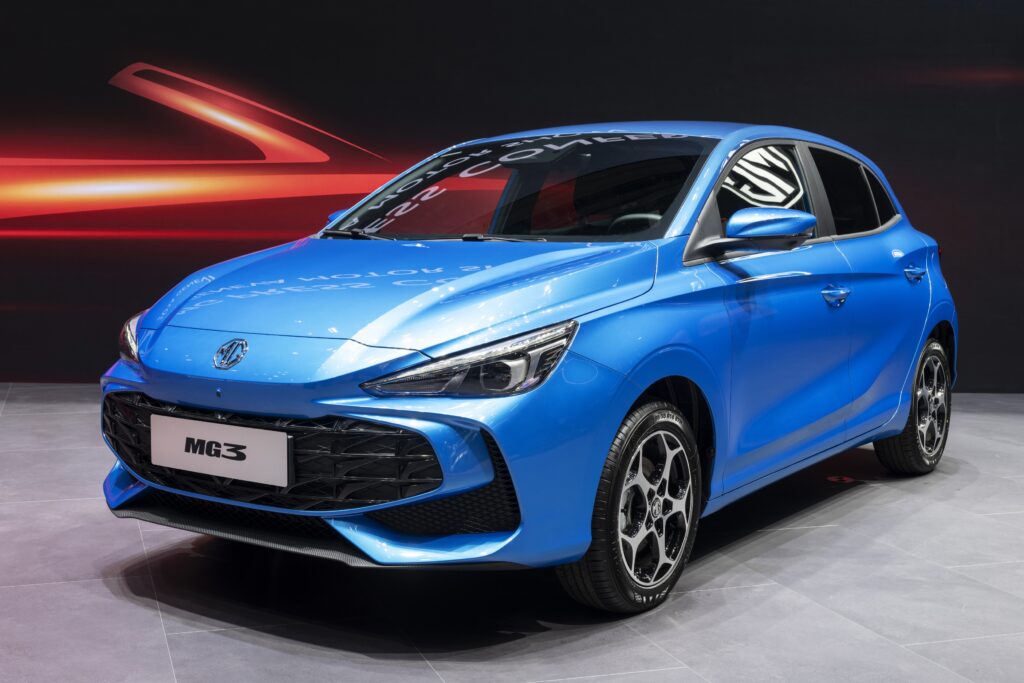Electric vehicles help UK new-car market return to growth
07 October 2024

Following its first decline in two years, the UK’s new-car market experienced growth in September. However, the positive figures hide some ongoing struggles for the automotive industry. Autovista24 special content editor Phil Curry examines the data.
The UK’s new-car market returned to growth in September, although the 1% increase will do little to lift spirits.
A total of 275,239 deliveries were made last month according to the latest figures from the Society of Motor Manufacturers and Traders (SMMT). This was the best September since 2020, but figures were down 19.8% compared to 2019, before the market was affected by the COVID-19 pandemic.
The 1% improvement in what is usually a bumper month due to the UK plate change highlights the country’s automotive market struggle. Since April, registration figures have not peaked over a 2.5% improvement, with most months below 2%. August saw 24-consecutive months of growth come to an end with a 1.3% decrease.
Year to date, deliveries have improved by 4.3% compared to the same period in 2023. This equated to a total of over 1.51 million units.
Yet, the UK has still fared better than other major markets in Europe. Germany has seen several large drops, as has Italy. France is experiencing a period of steep decline too.
The UK’s slow growth suggests that the boom following the end of the supply-chain crisis is now at an end. The cost-of-living crisis is not yet over, and drivers are therefore holding on to their cars for longer, rather than buying newer models. This was evidenced earlier in 2024, when the UK car parc’s average age reached nine-years-old, a full year above the figure recorded in 2019.
Fleets slowdown continues
Fleet registrations have driven the UK’s new-car market for some time. However, in August, volumes decreased year-on-year for the category, as the private sector took the lead in terms of growth.
During September, fleet deliveries bounced back slightly, but their 3.7% rise is small compared to the performances of previous months. Before August, the fleet market had recorded growth in the double-digits since September 2022. A total of 149,095 units were delivered to fleets last month.
This resulted in a 54.2% market share, up 1.5 percentage points (pp).
The sector was hit hard by COVID-19 and the start of the supply-chain crisis in 2021, with registrations tumbling 34.4% in September of that year. This means that this year, there are fewer cars to de-fleet and replace, which is a likely contributor to the slowdown. It remains to be seen if this trend will continue through the rest of 2024.
From January to September, fleet volumes increased 16.3% with 892,355 units. The category captured 58.9% of the new-car market, up 6pp.
Private consumer demand fell by 1.8% in September, with 120,272 deliveries accounting for 43.7% of the market. This was down from its 44.9% share from 12 months ago. Across the first nine months of the year, the category has declined 9.4%, with 588,616 registrations. Its share dropped 5.9pp to 38.9% in this period.
The smaller business sector saw volumes slump 8.4% in the month, to 5,872 units. It took a 2.1% market share, down 0.3pp. Year-to-date, deliveries decreased by 4.2%, equating to 33,123 units. The business sector accounted for 2.2% of registrations from January to September, down 0.2pp.
Petrol plummets
Registrations were driven by the electrified market, while the internal-combustion engine (ICE) models saw declines. This is even more significant as UK numbers incorporate mild-hybrid (MHEV) models with their relevant petrol and diesel figures. Other markets either separate their volumes, or more commonly, add them together with full-hybrids (HEVs).
Therefore, this shows that even MHEVs were unable to save the fossil fuel market, bolstering the trend that drivers are turning away from traditional powertrains.
Petrol registrations declined 9.3% in September, although they remained the highest-volume powertrain with 137,793 units. The fuel-type held 50.1% of the market in the month, down from the 55.7% recorded last year.
September’s performance pushed the petrol market into a year-to-date decline of 0.8%. Its market share dropped from 56.5% across the first nine months of last year, to 53.8% in the same period during 2024.
This decline should not be a surprise, based on recent performance of the powertrain. Petrol registrations started strongly in the first quarter, and at the end of March was 9.4% up across the first three months. Since then, however, the technology has not recorded a single monthly improvement, with September’s results the second worst of the year, after August’s 10.1% fall.
Since the start of the second quarter of the year, petrol registrations have declined by 6.1%. Therefore, the strong start to 2024 has kept the fuel-type from dipping heavily into the negative across the year to date.
Diesel deliveries fell by 7.1% last month, to 17,556 units. This gave the powertrain a 6.4% market share, only down 0.5pp on the same time last year. The fuel is now 12% down year-to-date, with 97,649 registrations. Diesel represented just 6.4% of new-car deliveries in this period, dropping 1.2pp.
Combining petrol and diesel volumes, the ICE market unsurprisingly slumped 9% last month. It took a market share of 56.4% in September, down 6.2pp. In the first nine months of the year, ICE deliveries fell 0.8%. However, its share suffered a steeper decline of 4pp to 60.2%.
Discounted BEVs
Battery-electric vehicles (BEVs) recorded a record volume for any month during September. Registrations grew 24.4% to 56,387 units, achieving a 20.5% market share. This was up 3.9pp compared to a year previously.
This performance meant BEVs were up by 13.2% across the first nine months of the year, with 269,931 deliveries. This was a 17.8% hold on the market, up from 16.4% seen at the same time last year and a 0.6pp improvement from the first eight months of 2024. The SMMT forecasts that BEVs will take an 18.5% market share in 2024.
As the end of the year approaches, so too does the requirement for 22% of a manufacturer’s sales to come from zero-emission vehicles (ZEVs). Therefore, the slow movement on overall market share, and the forecast that is 3.5pp lower than the mandate, is a concern to the industry.
Fleets drove much of the BEV registrations in September, with deliveries rising 36.8% to account for 75.9% of the technology’s overall total. Private demand also rose, albeit by just 3.6%. This equated to 410 more registrations compared to last year, as manufacturers discounted heavily to entice buyers in the month.
To highlight the problem that BEVs face in the private sector, demand for diesel grew at a faster rate, increasing 17.1% in September. This amounted to an extra 1,367 units than the same period in 2023. Year-to-date private BEV demand remains down by 6.3%.
The SMMT calculates that manufacturers are on course to spend at least £2 billion (€2.4 billion) on discounting electric vehicles (EVs) this year. This creates an untenable situation, where carmakers are also pouring billions into the development of the technology. Yet, the consumer market is not improving as it needs to.
A call for support
‘Previous assumptions of a market delivering steady BEV growth, cheaper and plentiful raw materials, affordable energy and low interest rates have not come to fruition, with the upfront cost of BEV models remaining stubbornly high. Added to this is consumers’ lack of confidence in the UK’s charging provision, despite recent investment and growth, which still acts as a barrier to BEV take up,’ the SMMT stated.
With the concerns over the end-of-year target rising, the industry organisation, along with 12 vehicle manufacturers including BMW, Ford, and Stellantis, have written to the UK Chancellor. Together, they are calling for measures to support consumers and help speed up the pace of the EV transition.
‘As an industry we will likely miss [the 22% ZEV mandate target for 2024] and a significant number of brands face the prospect of either buying credits from another company or paying swingeing compliance payments,’ the letter suggests.
‘These are not consequence-free choices. No company wants to support a competitor, especially if they may have had competitive advantages in production. And any amount will have to be provisioned, with a consequent cut in investment, R&D or jobs. And in any market, costs are invariably passed on, so it is the consumer who pays.’
The letter suggests that the UK Government take action to support the sector. This includes temporarily halving VAT on new EV purchases, which will help put an extra two million EVs on the roads by 2028. Plans to introduce Vehicle Excise Duty on BEVs next year should also be scrapped, while VAT on public charging should be lowered to match the 5% domestic rate.
Boost for PHEVs
Meanwhile, plug-in hybrids (PHEVs) saw the biggest registrations growth in September. The market improved by 32.1% as 24,486 new units too to the country’s roads. This allowed for a 2.1pp jump in market share compared to last year, with an 8.9% hold of new-car registrations in the month.
Across the first three quarters of the year, PHEVs have also been the best performer in terms of growth, with registrations up 26.2% in the year to date While PHEVs are unable to match petrol, BEV and HEV volumes, they are now comfortably ahead of diesel deliveries. Their 8.3% market share from January to September is 1.5pp up on the same period in 2023.
The PHEV performance, and BEV growth, meant EVs took 29.4% of all registrations in September, up from the 23.4% recorded last year. Deliveries grew 26.6% in the month, a stark contrast to ICE figures.
EVs also saw volumes surge in the year to date, up 17%. The powertrain grouping accounted for 26.1% of registrations, an increase of 2.9pp compared to the first nine months of 2023.
HEVs saw slight growth in September, with 39,017 units equating to a 2.6% rise in deliveries. This was 1,003 units higher than last year and gave the powertrain a 14.2% share of total registrations, a 0.3pp improvement year on year.
Across the year-to-date, HEVs are up 13.6%, with a market share of 13.7%, an improvement of 1.1pp. The powertrain is the third-most-popular option in the UK, although its slow growth in what is usually a bumper month highlights the sluggish nature of the UK new-car market at present.
Adding HEVs to EV deliveries, the electrified market represented 43.6% of new-car registrations in September, a sizeable growth from its 37.3% share 12 months ago. From January to September, the powertrain grouping took a 39.8% market share, surging 4pp.




